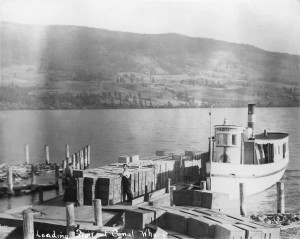In the days before good road and rail communication ser viced Oyama orchardists, the most efficient way to move fruit to market was via steamer to the north end of Kalamalka Lake where it was transferred to the Canadian Pacific Railway (CPR) station at Vernon. This photograph, part of the George Goulding collection held by the Lake Country Museum, shows one link in that network.
viced Oyama orchardists, the most efficient way to move fruit to market was via steamer to the north end of Kalamalka Lake where it was transferred to the Canadian Pacific Railway (CPR) station at Vernon. This photograph, part of the George Goulding collection held by the Lake Country Museum, shows one link in that network.
The navigation canal connecting the two parts of Long Lake (Kalamalka and Wood lakes) was opened on September 3, 1908 and the City of Vernon that had been operating on Kalamalka Lake since April 1908 was the first boat through the waterway. Owned by C. C. Pilkey, the City of Vernon sometimes pushed a barge and at other times took passengers and goods aboard the boat itself. The City of Vernon was joined on Long Lake by the Johnson and Carswell steamer, Maud Allen, the next year and by Princess Pat in 1916.
Packinghouses were another part of this network. A cannery operated for a few years at the north end of Wood Lake, the Vernon Fruit Union was established in Oyama in 1913 and the Sterling and Pitcairn plant was built on west bank of the canal in 1914. The Sterling and Pitcairn wharf apparently extended out into Wood Lake, likely because the canal was too narrow. In this photograph, we see the City of Vernon docked at the Sterling and Pitcairn wharf, circa 1917, while workers truck boxes of apples onto the barge that will be towed to the north end of Kalamalka Lake.
Source: Much of this information was taken from the Oyama Timeline. 1871 to 1995 by Ken Ellison, available on this website. Also available on the website is a small sampling of photographs from the Goulding (George & Maisie) Album. Click on photograph to enlarge it.







0 Comments